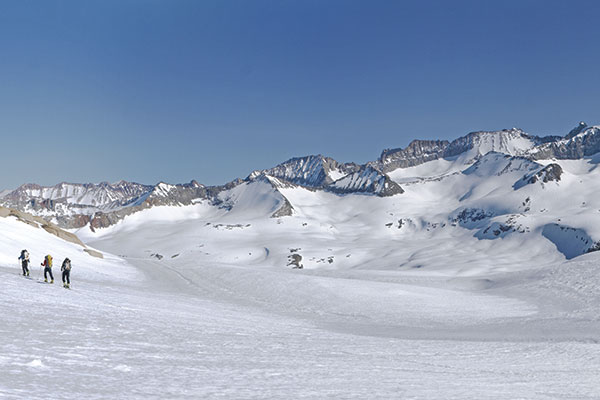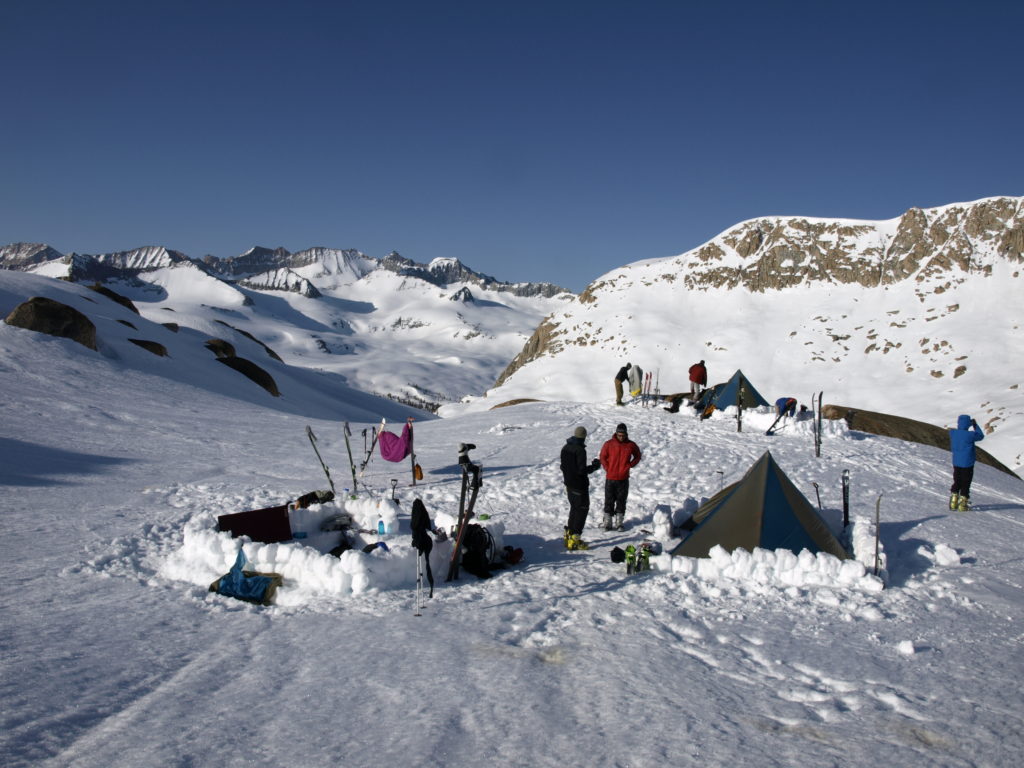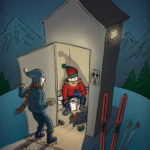Now that backcountry skiing has tickled the consciousness of mainstream skiers, all sorts of destinations have become normal fare for the typical core skier. From the Green Mountains of Vermont to Washington’s Cascade Range, Wyoming’s Tetons, Utah’s Wasatch, or California’s Sierra Nevada, the tracks of turn earning skiers are plainly visible where chairlifts are absent.
However, while the evidence of turn earning skiers are more plentiful than ever, their tracks subside rather quickly the further you get from the road. Instead of fanning out and becoming more plentiful everywhere it seems they have only expanded the range near roads. Even from pure backcountry trailheads the inclination for exploring beyond known popular trailheads is rare. Deep and remote destinations remain as wild and untraveled as ever, in some cases, even more so.
It seems the conveniences of daily life in America have come with a hidden cost where the extra time promised by technology is simultaneously robbed by the time required to pay for it. Unless you live in the mountains, and even if you do, finding the time to break away for more than a day tour becomes more and more rare.
Consider just one ‘popular’ tour where remoteness is a key part of the trip – the classic Sierra High Route. First defined by Dave Beck in 1975, it traverses the width of the Sierra Nevada between Shepherd’s Pass on the east side and Wolverton to the west. Much of the route stays above 10,000 feet as it crosses seven high passes along its 50-mile length.
Even though the number of backcountry skiers is dramatically higher than in the 80s and 90s, the number of people skiing the SHR is flat or down. Why is a mystery. My theory is it’s a mental thing. Going on day tours is mildly adventurous, but you’re never too far from help if needed. Crossing the Sierra on skis help is in your pack and who you’re with, not a phone call away.
That’s part of the mental reason so few experience the SHR. The other is a simple misunderstanding of the value to be gained, not so much from the risk point of view, but knowing it isn’t about face shots and rad lines; it’s more about backpacking on snow using skis to travel. It’s not a thrill ride; it’s more of a zen ride.
Satisfaction comes from being able to traverse the width of the Sierra under your own power, with the speed and agility that skis allow. With a good group and good weather there will be opportunities for some righteous turns, but if turns are your only motivation you will feel severely under compensated.
So what could the motivation possibly be? It is two fold. As just mentioned, there is a satisfaction that comes from achieving such a monumental undertaking. Secondarily it is a stunning visual feast of mountain terrain, in skiable conditions.
The challenge of crossing the Sierra with a small team of like-minded individuals is both mental and physical. It involves climbing several thousand vertical feet per day over the course of approximately 10 miles a day with a 40-pound pack. You can get away with a lighter pack; Otto Steiner made a two-week solo tour there and back with only a 20-pound pack in the 1930s.
I’ll admit I had a hard time leaving everything behind. In all likelihood your pack will be closer to 50 pounds and if it is, your unwillingness to sacrifice at the trailhead means more suffering on the trail. With each meal though, your pack will loose weight, while you, theoretically, gain strength and stamina.
That is the crux of the second challenge, mentally acknowledging and accepting that even should you manage to pare down your pack to a mere 35 pounds, there will be some suffering involved. If you prepare well most of the suffering will be mere physical discomfort on a long climb. It does not mean you need to leave so much behind that you’re freezing at night, or starving. It also means knowing how to stay hydrated enough to be able to push through the lassitude that comes with altitude.
The importance of the mental and physical stamina required was underscored on a trip across the Sierra in May 2011. Before we donned packs and headed up the trail, our guide Geoff Clarke, gave us all a little pep talk on how this was a strenuous undertaking and we needed to work together as a team to make it. I’d been on this same trip with him two years earlier with no such introduction so I figured it was just a new protocol he adopted.
The sun was out and the temperatures were warm as six of us climbed from 7,000 feet to the first pass at 9,500-feet on the trail to Pear Lake Hut. We all stripped down to T-shirts while sweat poured from our brows. One guy complained about his pack and how he felt completely maxed out. The rest of us tried to encourage him that this was normal but when we got to the top of the climb he wanted to quit.
There was little doubt he had too much unnecessary stuff in his pack, but he wasn’t alone in that regard either. It didn’t help that he was using the NTN Freeride with TX-Comp boots which made skinning more laborious than a rig with a free pivot and smaller, lighter boots. However, later in the week we ran into a guy using Hammerheads which have no free pivot for touring and that guy was happy as a clam with no complaints whatsoever, and an equally heavy pack so the physical discomfort only magnified the mental.
In vain we tried to convince him this was just part of the game and he would get used to it. He was adamant he was ill prepared and didn’t want to hold us up. When a pair of skiers happened by, heading back down to the trailhead our guide let him bow out.
If he was whining that much on the first climb of the route, with many more to come, and at higher altitude, the mental fortitude was simply lacking. Skinning with a 45 pound pack is strenuous, but it shouldn’t require 90% output all the time. Whatever he did for training obviously hadn’t prepared him for hours of uphill climbing with a pack.
His loss would be our gain. He was right, he would have been a burden and while we needed to work as a team, everyone on the team needs to be able to carry his own weight too. We still had our moments where we needed to hunker down and help one another along.
On one occasion our route took us up steep frozen snow nestled among cliffs. If we had all been willing to carry the extra weight of crampons we could have flashed an exposed section in 15 minutes as a group. But we didn’t, and the sacrifice cost us more than two extra hours of setting up a fixed line and chopping steps to make the same journey.
Even in this, however, there was a benefit, the kind I’m alluding to that can’t be explained so much as experienced. To make this crossing required more than setting up the fixed line and chopping steps, it required mental encouragement to those who were more nervous by not merely offering to carry their load, but doing so in a way that did not insult their pride. For some in the group this was normal mountaineering. With experience you learn how to focus on the task at hand and block out the consequences of a mistake and just not make one. For one guy though, the lack of experience with that exposure played serious games with his confidence. Rock climbers are intimately familiar with this, as well as the camaraderie that results from sharing the sensation of being scared shitless.
Which is part of what skiing the Sierra High Route is about. Testing yourself mentally and physically along side others, with strangers who become friends, or friends who become better friends. It was a subtle shift, but after that incident we were a tighter group.
The second reason you want to ski the SHR, the one that words fail to convey, is the opportunity to immerse yourself in the 24/7, 360-degree panoramic majesty of the Sierra that only a handful of people in the world will ever see and experience. To that end consider the panoramas in this article as an inadequate tease of the real thing. Pictures are said to be worth a thousand words but both fall short of the glory of actually being out there in the midst of what John Muir called the Range of Light.
So do yourself a favor. Gird your mind and chasten your body in preparation for a week of adventure skiing the Sierra High Route. Though I didn’t promote it much, you’ll even get a few righteous turns in along the way. Not the first day, but every day will take you over at least one pass, sometimes three, and with each climb up there will be turns on the other side. If you make good time, you can easily set up camp and then do a quick lap before the sun sets, especially if you make the crossing in May when the sun sets late.
The standard route starts in the east at the Shepherd’s Pass trailhead and heads west to Wolverton. The first day is a four to five thousand foot climb on dry trail with a full pack and skis on your back. In exchange for a brutal day one, most of your descents will be on west or south facing slopes that tend to provide easy skiing corn snow.
The other option is to start on the west side, out of Wolverton. You may start this easterly traverse with skis on you back, but you’ll soon be skinning and keep your skis underfoot until the last day when you hike down the dry trail with a lighter pack. Descents tend to be on eastern and northerly slopes which can get crusty late in the day but you also get to ski the Superbowl, a four-thousand foot descent from the Tyndall Plateau to the Shepard’s Pass trail. It is a fitting grand finale for a trip dominated by skinning time.
Either way to travel it, this is one trip you won’t regret and will recall with fondness for decades.
Guides:
Alpine Skills International
530-582-9170
Sierra Mountain Center
760-873-8526
Sierra Mountain Guides
877-423-2546
Sierra Mountaineering International
760-872-4929
www.sierramountaineering.com
760-760-872-492
Craig Dostie migrated from Michigan to California the year before the great El Nino winter of 82/83 and subsequently became a rabid proponent of backcountry skiing. He went on to create Couloir and Telemark Skier magazines and continues to promote human powered skiing as a Senior Editor at Backcountry Magazine and write my essay easy way on his website EarnYourTurns.com















